 |
||
|
||
| ||
TABLE OF CONTENTSAs is well known, ATI Technologies has recently announced the launch of new products, Hi-End (X1950) and top Middle-End models (X1900XT 256MB) so far, but cheaper models will follow soon. However, we already know about the X1300 XT and the X1650 PRO, though they are essentially renamed X1600 PRO and X1600 XT cards that were moved to other price segments - but they are all below $199. This segment is the most popular in our parts, by the way - there will be wars in this segment. As we can see, NVIDIA is attacking now, without waiting for the opponent. Today we are going to examine GeForce 7900 GS, which is a direct heir to GeForce 7900 GT. In fact, it is based on this model. Just a curtailed GPU - fewer pipelines and units. Hence the lower price. I'd like to file a complaint from the consumer's point of view. How long will they torture users with their indices and suffixes? Few users understand, which card is faster: the 7900GS or the 7800GTX. Or the 7800 GTX versus the 7900 GT. Plus two kinds of the 7800 GTX card with different memory sizes and frequencies. Two zeros in all the names. Is it really so difficult to find an intermediate number? 7850, 7920, 7870, etc. The marketing department will object, of course. This card was the last to launch, it's a new product. According to its performance, it should be named 7880 or something like that. But we already have the 7900 and the 7950. That's why manufacturers strain every nerve to increase the numbers, equipping their products with absurd suffixes. So, the 7900 GS is just the 7900 GT - 450 MHz core and 660 (1320) MHz memory. But the 7900 GT features 24 pixel units, 8 vertex pipelines, 24 texture units, and 16 ROPs. While the 7900 GS has just 20 pixel units (1 quad is removed), 7 vertex pipelines, 20 texture units and the same 16 ROPs. That is G71 is very cheap and productive. It's already used in the 7950GX2, the 7900 GTX, the 7900GT, and now the 7900GS. I suspect that the cards use sterling chips (24/8/24/16 units) with some units locked down. But a sterling chip cannot be used in the $199 segment, if you don't want to bring down the market. All cards are manufactured for their price fork, they can move into another segment only after they get obsolete and discontinued. So it's just impossible to move the sterling 7900 GT from the $299 level to $199 - it will hit hundreds of partners and clients, who already bought these cards for the old price and just didn't sell them yet. That's why the dreams of getting the 7900 GTX or the X1900 XTX for $200 will remain dreams. Perhaps we may see such prices in a couple of years, when these cards are things of the past and vendors start selling out the left-overs. But who will need such cards then - there will appear new Middle-End cards supporting all new functions. We know that new Middle-End cards may sometimes outperform old High-End cards. The new cards will appear on the shelves on September 6th. Let's find out what we'll get from the new product.
Video card
Evidently, GeForce 7900 GS = GeForce 7900 GT in terms of PCB, layout, etc. That's the right decision. The 7900 GT PCB is surprisingly cheap for a 256bit PCB. It's even expedient at such a price. This segment used to offer only 128-bit products. For example, GeForce 7600 GT. Now it goes down to the $149 level.
The card has TV-Out with a unique jack. You will need special bundled adapters to output video to a TV-set via S-Video or RCA. You can read about the TV-Out in more detail here. Analog monitors with d-Sub (VGA) interface are connected with special DVI-to-d-Sub adapters. Maximum resolutions and frequencies:
What concerns the cooler, the product is equipped with the same reference cooler as in the 7900 GT. Made of copper alloy, it's a closed heatsink with an off-center fan. This device efficiently cools the GPU, remaining nearly noiseless:  Memory chips are not equipped with heatsinks, but they do not get very hot. Besides, the memory operates at a lower frequency than the nominal value. A note to overclockers: it has been impossible to unlock pipelines since the 7800 GT times, GPUs are locked down on the hardware level. So you should forget about getting 24/8 pipes in such cards.
It's an engineering sample, so the bundle and package are out of the question.
Installation and DriversTestbed configuration:
VSync is disabled.
Test results: performance comparisonWe used the following test applications:
Summary performance diagramsNote that we have run two test sessions: of a single card and of the SLI mode (two accelerators). GeForce 7900 GS Results
Game tests that heavily load vertex shaders, mixed pixel shaders 1.1 and 2.0, active multitexturing.FarCry, Research
Game tests that heavily load vertex shaders, pixel shaders 2.0, active multitexturing.F.E.A.R.
Splinter Cell Chaos Theory
Call Of Duty 2 DEMO Half-Life2: ixbt01 demo

Game tests that heavily load pixel pipelines with texturing, active operations of the stencil buffer and shader unitsDOOM III High mode Chronicles of Riddick, demo 44

Synthetic tests that heavily load shader units3DMark05: MARKS 3DMark06: Shader 2.0 MARKS
 3DMark06: Shader 3.0 MARKS
 I didn't comment on each test, because the 7900 GS leads in almost all tests, the X1800GTO is defeated. Even the more expensive (so far) X1900 GT is often outperformed. So GeForce 7900 GS is the leader among $200 accelerators. It has its disadvantages, of course. We'll mention them in our conclusions.
GeForce 7900 GS SLI Results
Game tests that heavily load vertex shaders, mixed pixel shaders 1.1 and 2.0, active multitexturing.FarCry, Research
Game tests that heavily load vertex shaders, pixel shaders 2.0, active multitexturing.F.E.A.R.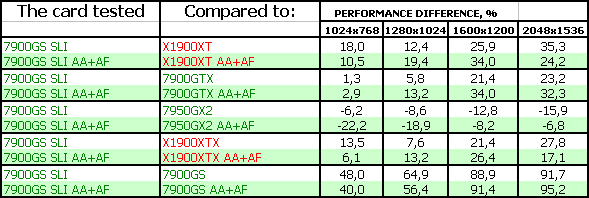
Splinter Cell Chaos Theory
Call Of Duty 2 DEMO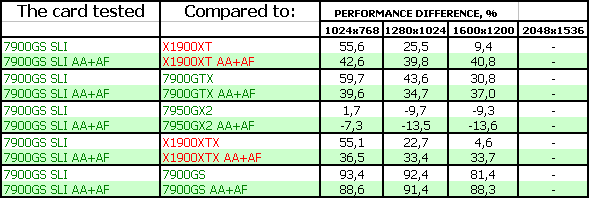 Half-Life2: ixbt01 demo
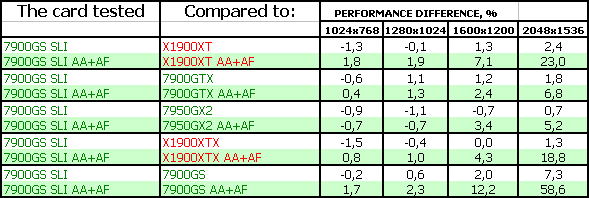
Game tests that heavily load pixel pipelines with texturing, active operations of the stencil buffer and shader unitsDOOM III High mode Chronicles of Riddick, demo 44

Synthetic tests that heavily load shader units3DMark05: MARKS 3DMark06: Shader 2.0 MARKS
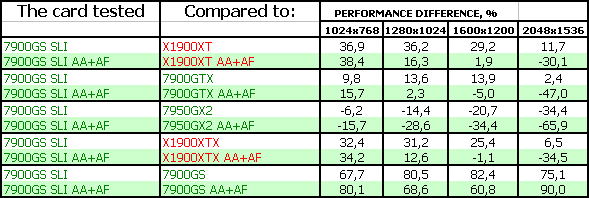 3DMark06: Shader 3.0 MARKS
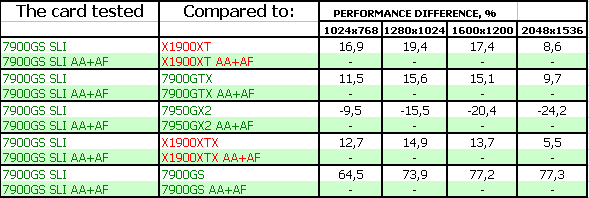 It's always much more difficult to compare SLI tandems. First of all because they are not as popular as single cards. Another reason - not all users who dream of a powerful accelerator will install two Mid-End products in SLI mode. A user most often sells his/her old accelerator and buys a new powerful card. Nevertheless, according to our performance analysis, this $400 tandem (that's the recommended price, it will be initially more expensive) fairs well even versus 7900 GTX, which is evidently more expensive. Even the more expensive X1900 XTX is outperformed. So the 7900 GS SLI is good. But don't forget that you must have a SLI motherboard and a good power supply unit. Conclusions
NVIDIA GeForce 7900 GS 256MB PCI-E. So, our tests demonstrate that this product takes up the lead among $200 video cards. Of course, you should keep tabs on the prices. If it's too high, you should draw corresponding conclusions. But even if this card initially costs $220-$240, it's still good - it sometimes outperforms the more expensive X1900 GT. It lacks VIVO (but the partners are free to install Philip 7115 for this purpose) and HDR+AA (a downright disadvantage). But the latter disadvantage is more relevant for Hi-End rather than for Middle-End (you will hardly enable HDR+AA on such a card). What concerns the card itself, it has worked great, we have no gripes with its operation, it has demonstrated excellent 2D quality! We haven't tried overclocking. But I think we'll analyze this issue, when production-line cards are available. And now what concerns drawbacks. The fact is, GeForce 7900 GT users started complaining about inexplicable slowdowns (freezes) without the cards getting overheated. Besides, the cards are not very stable. Forums are full of the disputes about the reasons. Many people blame the users themselves - they overclock the cards and then complain about instabilities. But some users do not overclock their cards and they still complain about the issue. Considering that the 7900GS inherits everything but the cores from the 7900GT, I'm afraid that the "virus" might have migrated here as well. I hope that NVIDIA and its partners are taking measures already. I hope ATI will soon respond to NVIDIA's challenge and will launch a new product in the $200 segment, much better than the X1800GTO. Competition is very important. Consumers only benefit from it.
You can find more detailed comparisons of various video cards in our 3Digest.
Theoretical materials and reviews of video cards, which concern functional properties of the GPU ATI RADEON X800 (R420)/X850 (R480)/X700 (RV410) and NVIDIA GeForce 6800 (NV40/45)/6600 (NV43)
Write a comment below. No registration needed!
|
Platform · Video · Multimedia · Mobile · Other || About us & Privacy policy · Twitter · Facebook Copyright © Byrds Research & Publishing, Ltd., 1997–2011. All rights reserved. | |||||||||||||||||||||||||||||||||||||||||||||||||||||||